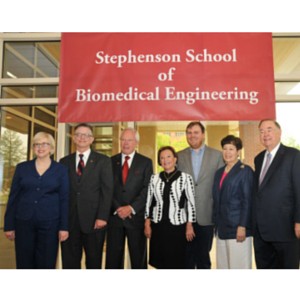NORMAN -- University of Oklahoma President David L. Boren today announced more than $30 million in new resources to name the College of Engineering and establish a new School of Biomedical Engineering, including construction of a new academic building in the Engineering Quadrangle, and establishment of 12 new endowed positions and formation of a $3.5 million endowment for graduate fellowships.
The resources are being made possible through major gifts from Janet and Jim Gallogly of Houston and Peggy and Charles Stephenson of Tulsa and the Stephenson Family Foundation.
“These two major gifts will provide the greatest infusion of new resources in the history of the College of Engineering,” Boren said. “They will strengthen the entire college and will put OU in the forefront of the growing field of biomedical engineering,” he said. “We are deeply grateful to the Gallogly and Stephenson families.”
In addition to serving the full College of Engineering community, the new academic building to be constructed will house the new School of Biomedical Engineering, which will integrate engineering and medicine and will further develop three areas of existing strength in the College of Engineering: biomedical imaging, nanomedicine and neuroeningeering.
In appreciation of the gifts, Boren said he will recommend to the OU Board of Regents that they recognize the donors by naming the College of Engineering and the new academic building in honor of Gallogly and that the new School of Biomedical Engineering be named in honor of the Stephensons.
Gallogly, who serves on the Board of Visitors for the OU College of Engineering, worked for Phillips and later Chevron Phillips Chemical and ConocoPhillips in a career spanning almost 30 years. Upon joining Phillips in 1980, he held various roles in exploration and production, refining, chemicals, legal and finance, including international assignments. He rose to senior vice president of chemicals and plastics, vice president of olefins and polyolefins and vice president for North America production. He joined Chevron Phillips Chemical as president and chief executive officer in 2000. Six years later, he joined ConocoPhillips, serving first as executive vice president of refining, marketing and transportation. In 2008 he was named executive vice president of exploration and production.
He then became the CEO of LyondellBasell, one of the world’s largest plastics, chemical and refining companies, serving as CEO from 2009 until his retirement in 2015.
Gallogly has served on the boards of directors of the American Chemistry Council and the Society of Chemical Industry. He also has served on the board of directors and executive committee of Junior Achievement of Southeast Texas. An OU law alumnus, he is a member of the Oklahoma, Texas and Colorado bar associations. For leadership in his profession, OU awarded Gallogly an Honorary Degree in 2012.
Gallogly’s gift will also renovate one of the most important laboratories in the college, the 1,800-square-foot Chemical Engineering Undergraduate Laboratory, which is used for two vitally important practice courses required for all chemical engineering majors. In the Unit Operations Lab course students in their junior year gain hands-on experience with many functions typical of the chemical process industry, including unit operations and measurements. The Chemical Engineering Design Lab course affords students in their senior year opportunities to conduct more complex experiments for large-scale design projects. The lab is also frequently used for demonstrations, engineering camps and outreach activities involving K-12 students and their families.
The School of Biomedical Engineering is being created to respond to the increase in biomedical engineering jobs anticipated as the world population continues to grow and age. CNNMoney cited biomedical engineering as the top jobs field for the period 2010 to 2020 with median pay of $87,000 and 10-year growth of almost 62 percent in employment opportunities.
To help create the school, Peggy and Charles Stephenson have pledged a major gift from the Stephenson Family Foundation. Peggy Stephenson is executive director of the foundation, and Charles Stephenson is a 1959 OU petroleum engineering graduate and retired chairman of the board, president and CEO of Vintage Petroleum Inc., which was sold in 2006 to Occidental.
The Stephensons, who grew up in the southeastern Oklahoma community of Antlers, are longtime partners in philanthropy, parenting and life. Their gifts have helped develop OU’s rapidly growing Research Campus in Norman, thus benefitting research progress and economic development in the state of Oklahoma. In 2002, their gift to OU helped build a Research and Technology Center, which transformed an empty field into OU’s now-burgeoning Research Campus. Four years later, they made a lead gift to help build a Life Sciences Research Center, and in 2010, the Stephensons presented OU with a naming gift to benefit cancer programs for all of Oklahoma and by creating the Stephenson Cancer Center. OU awarded Peggy Stephenson an Honorary Degree in 2008 and Charles Stephenson an Honorary Degree in 2003.
The School of Biomedical Engineering, which will enroll its first students for the 2016 academic year, will be uniquely positioned to enhance collaboration throughout the Oklahoma biomedical community and across the multiple campuses in Oklahoma: OU Norman, OU-Tulsa, OU Health Sciences Center, the University of Tulsa, Laureate Institute for Brain Research, Oklahoma Medical Research Foundation and private companies in the medical technologies/healthcare industry.
The School of Biomedical Engineering will enhance diversity in both the student and faculty ranks, increase enrollment and federal research funding and spur economic growth. It will also aid in the recruitment of top students and strengthen collaboration among OU’s three campuses.
While many National Merit Scholars are attracted to OU because of the strength of the University’s existing biomedical engineering programs, OU students currently enrolled in biomedical engineering and pre-med options have expressed the strong desire for a full major in the field.
The School will offer a curriculum designed to help its graduates save lives and improve quality of life while addressing the challenges of more effective and efficient healthcare.
Photo from left to right: Patti Landers, Dean Tom Landers, Charles Stephenson, Peggy Stephenson, Corry Stephenson, Molly Shi Boren, David L. Boren.



